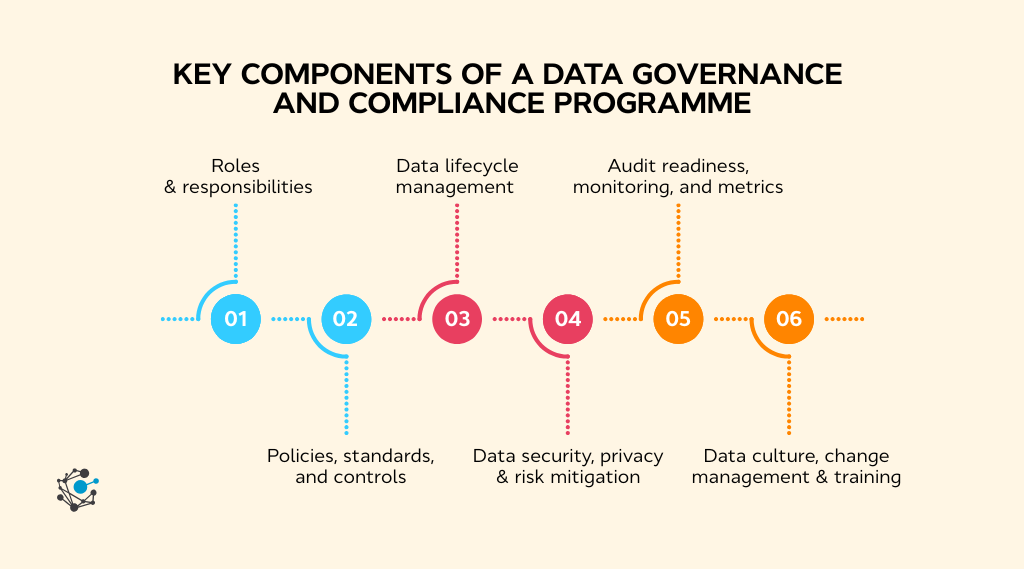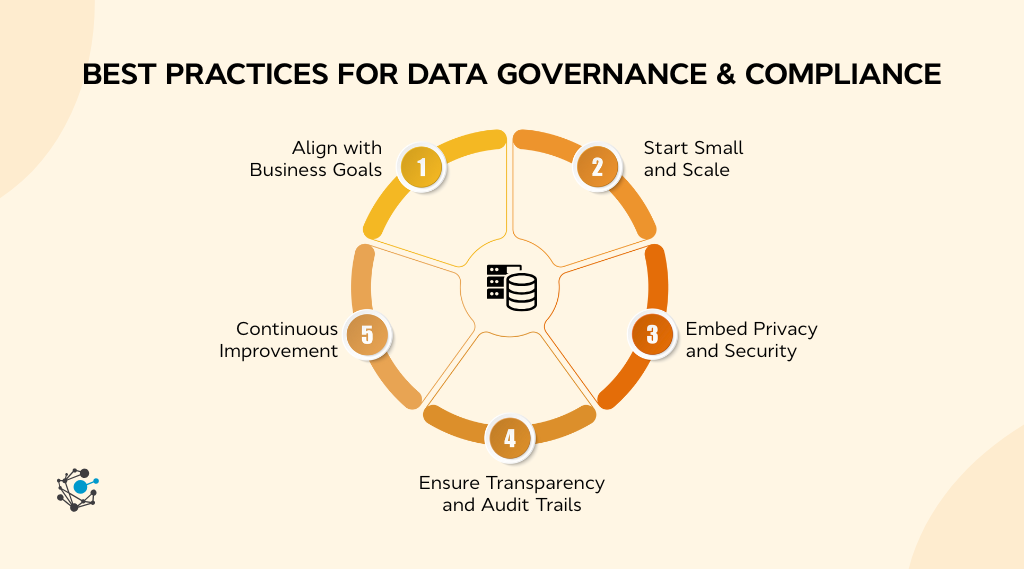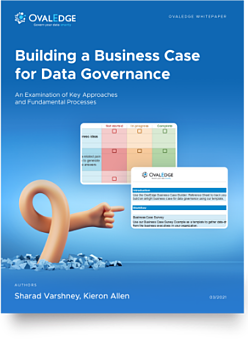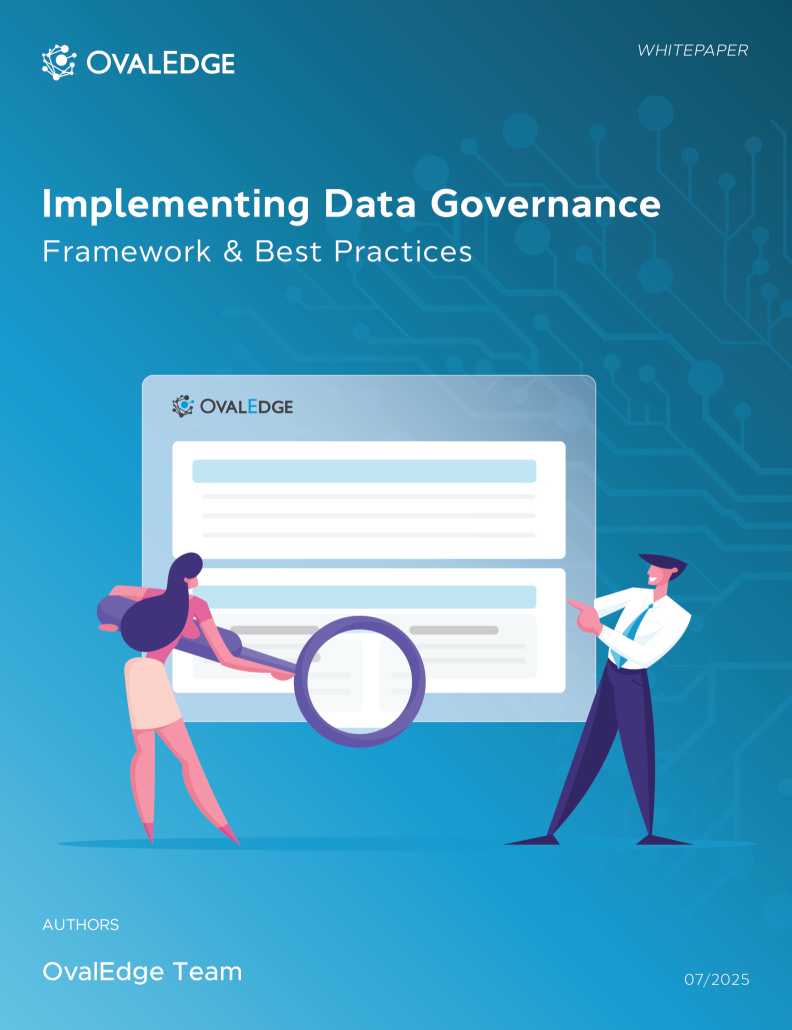Table of Contents
Data Governance & Compliance Framework: Best Practices for 2025
A rising regulatory landscape and mounting breach costs make disciplined data governance and compliance essential. This guide outlines the frameworks, roles, controls, and cultural shifts required to manage data responsibly. It shows how integrated lifecycle controls, automation, and audit-ready transparency, supported by platforms like OvalEdge, turn governance from a risk blocker into an operational enabler.
You’re collecting more data than ever, across teams, tools, and touchpoints. But here’s the catch: without the right guardrails, that data quickly becomes a liability. Mismanaged access, outdated records, unclear ownership... sound familiar?
Now add rising regulatory pressure to the mix.
According to IBM’s Cost of a Data Breach Report 2024, the average cost of a single data breach has soared to $4.88 million.

That’s not just a line item, it’s a wake-up call. If you’re relying on scattered spreadsheets, manual processes, or siloed data policies, you're not just risking non-compliance; you’re risking business continuity, reputation, and trust.
What you need is a clear, scalable way to govern your data and stay compliant, without slowing down operations.
If your team is ready to turn this challenge into a capability, tools like Ovaledge can help automate the heavy lifting, so you can focus on what matters: using data responsibly and confidently.
What is data governance and compliance?
At a glance, data governance and data compliance might sound interchangeable, but they serve different, yet complementary, purposes in your data strategy.
-
Data governance is the internal framework that your organization establishes to manage, control, and ensure the quality of its data. It includes setting policies, assigning roles, and creating standards for how data is collected, stored, shared, and secured.
-
Data compliance, on the other hand, is about ensuring that your data handling aligns with external laws and regulations, such as GDPR, HIPAA, CCPA, or industry-specific mandates. It's how your governance practices hold up under legal and regulatory scrutiny.
In short, governance is about how you manage your data, while compliance ensures you're doing it within the rules. One sets the foundation, the other keeps you in check.
Together, they ensure that your data is not just well-managed but also trusted, secure, and legally sound.
Why is data governance and compliance important?
If you're managing growing volumes of data without a clear governance and compliance strategy, you're walking a tightrope. Here’s why these pillars of data governance and compliance are critical to your business:
-
Regulatory requirements: From GDPR and HIPAA to CCPA and PCI-DSS, regulations are tightening worldwide. Non-compliance can lead to massive fines, legal action, and public backlash. A governance-compliance framework helps you stay ahead of these risks, before regulators come knocking.
-
Data security and privacy: Without clear access controls, encryption policies, and audit trails, your sensitive data is vulnerable to breaches. Governance ensures the right people have access to the right data, and compliance ensures it’s protected under law.
-
Data integrity for decision-making: If your data is duplicated, outdated, or stored in silos, how confident are you in your reports? Governance keeps your data clean, consistent, and usable across teams.
-
Building customer and stakeholder trust: Transparent data practices signal that you take data protection seriously, critical in winning long-term trust from customers, partners, and investors.
-
Operational efficiency: A clear governance framework eliminates redundancy, improves data discoverability, and reduces manual effort, helping your teams move faster with fewer risks.
Data Governance vs. Data Compliance: Key differences
While data governance and data compliance often go hand in hand, they serve distinct roles in your data strategy. Think of governance as the internal roadmap and compliance as the legal checkpoint. One helps you manage data proactively, the other ensures you're meeting external obligations.
Here's a side-by-side breakdown:
|
Aspect |
Data Governance |
Data Compliance |
|
Focus |
Frameworks and policies for managing data |
Adherence to laws and regulations |
|
Goal |
Improve data quality, security, and usability |
Meet legal and regulatory requirements |
|
Scope |
Broad: includes data ownership, quality, metadata, and privacy |
Narrower: focused on specific legal standards |
|
Tools & Techniques |
Data cataloging, lineage, stewardship, metadata management |
Compliance audits, legal frameworks, and regulatory mappings |
|
Role in Organization |
Operational efficiency, data quality, and decision support |
Risk mitigation, legal safety, and audit readiness |
|
Enforcement |
Internal governance teams and policies |
External regulators and compliance bodies |
How governance and compliance fit together
Data governance creates the structure and processes for managing data across its lifecycle, ensuring it's accurate, accessible, and secure. Compliance ensures that those processes align with regulatory requirements like GDPR, HIPAA, or CCPA.
Without governance, compliance efforts are often reactive, scattered, and hard to maintain. Without compliance, even the best governance program can fall short in legal scrutiny.
|
Also Read: Top 9 Cloud Governance Tools to Try in 2025 |
Key components of a data governance and compliance program
Establishing a successful data governance and compliance programme requires embedding governance into the fabric of your operations, people, processes, and systems, so that every action taken with data is secure, compliant, and value-generating.
Below are the foundational components that make a programme scalable, sustainable, and audit-ready.

1. Roles & responsibilities (Data ownership, stewardship, CDO)
Clear accountability is the backbone of any governance framework. Without clearly defined roles, data initiatives often stall or fail.
-
Data owners: Senior-level individuals responsible for the business use of specific datasets. They define how data should be classified, accessed, and used. Their accountability includes authorizing access, ensuring data accuracy, and aligning usage with business goals.
-
Data stewards: Operational guardians of data quality and compliance. They maintain metadata, validate data against business rules, monitor quality KPIs, and ensure classification and tagging policies are enforced. They often act as the bridge between IT and business units.
-
Chief data officer (CDO): Sets the strategic direction for governance. The CDO oversees policy creation, stakeholder alignment, compliance mapping, and performance metrics. They ensure the governance programme is aligned with business outcomes and regulatory requirements.
- Other supporting roles:
-
Data custodians (often IT): Ensure technical implementation of governance controls such as access, storage, and backups.
-
Compliance officers: Work alongside governance teams to ensure ongoing alignment with legal and regulatory frameworks.
-
Executive sponsors: Provide budget, visibility, and organizational support to governance initiatives.
-
Why it matters: Without clearly assigned responsibilities, data governance lacks enforceability. Defining and documenting roles ensures accountability, simplifies audits, and builds trust across departments.
2. Policies, standards, and controls
Policies are the rules. Standards make them measurable. Controls make them enforceable.
-
Data access policies: Define who can access what data, under what conditions, and for what purposes. Should include role-based access controls (RBAC), approval workflows, and data masking requirements.
-
Retention & archiving standards: Specify how long different types of data must be kept and when they should be archived or deleted, in alignment with regulations like GDPR (right to erasure) or HIPAA (medical record retention).
-
Classification standards: Classify data based on sensitivity, such as Public, Internal, Confidential, and Restricted. These tiers drive security, sharing, and compliance measures.
-
Usage guidelines: Define acceptable usage for analytical, operational, and external sharing purposes.
-
Regulatory mapping: Link your internal controls to external regulations such as SOX, CCPA, PCI-DSS, and industry-specific standards (e.g., FISMA, FERPA).
Why it matters: A policy without standards is vague; without controls, it's unenforceable. Together, they form the rulebook that governs data use and compliance.
3. Data lifecycle management (From ingestion to disposal)
Governance must extend across every stage of the data lifecycle—not just storage or reporting.
-
Ingestion: Apply validation rules at the point of entry (e.g., data from CRM, web forms, APIs). Ensure PII or sensitive data is flagged immediately for downstream processing.
-
Storage: Enforce secure storage policies, e.g., encryption at rest, backup frequency, geo-location restrictions for data sovereignty.
-
Processing & transformation: Maintain lineage tracking and documentation of transformation logic (ETL/ELT) to support data accuracy and auditability.
-
Usage & sharing: Apply usage policies based on data classification. Ensure logs track who accessed or shared data, when, and why.
-
Archiving & disposal: Automate retention schedules and defensible deletion processes. Ensure deleted data cannot be reconstructed and that disposal logs are retained for audit trails.
-
Metadata management: Track lineage, definitions, owners, and classifications at every stage to maintain visibility and traceability.
Why it matters: Lifecycle-based governance ensures that data remains secure, accurate, and compliant, from creation to deletion, reducing both risk and storage bloat.
4. Data security, privacy & risk mitigation
This is the compliance-critical intersection of governance and cybersecurity.
-
Access controls: Enforce least-privilege access through RBAC or ABAC (attribute-based access control). Regularly review access rights and automate de-provisioning.
-
Encryption: Use encryption for data at rest, in transit, and during processing (where possible). Employ field-level encryption for high-risk fields like SSNs or credit card data.
-
Audit logs & monitoring: Maintain immutable logs of access, changes, and policy violations. Use SIEM tools or integrate with platforms like Ovaledge for real-time alerts and dashboards.
-
PII & sensitive data handling: Automatically identify and tag PII using data discovery tools. Apply masking, tokenization, or anonymization based on use cases.
-
Third-party risk management: Monitor vendor compliance, data sharing agreements, and downstream processing risks. Maintain a register of all data processors and sub-processors.
-
Data breach response plan: Define clear roles, escalation paths, communication protocols, and regulatory reporting obligations.
Why it matters: Regulatory fines aside, a breach can erode years of customer trust. Integrated security and governance reduce exposure and streamline incident response.
5. Audit readiness, monitoring & metrics
If you can’t prove it, it doesn’t exist, especially in the eyes of regulators.
-
Compliance reporting dashboards: Use tools like Ovaledge to visualize compliance scores, data quality trends, and access risk maps.
-
Audit trails: Maintain detailed logs of data changes, access history, and policy updates. Ensure logs are tamper-proof and exportable for audits.
-
Key performance indicators (KPIs): Track:
-
% of data with clear ownership
-
% of sensitive data classified
-
Policy adherence rates
-
Time to respond to compliance requests (DSARs, audit findings)
-
Number of unresolved data quality issues
-
-
Automated monitoring: Set up anomaly detection for policy violations (e.g., unauthorized access to restricted data). Use alerting to proactively catch compliance drift.
Why it matters: Audits are inevitable. Continuous monitoring and transparent metrics ensure you’re always prepared.
6. Data culture, change management & training
Even the most sophisticated tools and policies will fail if the people don’t follow them.
-
Training programs: Conduct onboarding and recurring training sessions on data handling, privacy laws, and governance tools. Tailor content for roles (e.g., analyst vs. engineer vs. executive).
-
Change management framework: Follow structured approaches like ADKAR or Kotter’s model to introduce governance changes. Include feedback loops and stakeholder engagement plans.
-
Communication strategy: Share the “why” behind policies and connect them to real risks or business outcomes (e.g., “Following this process reduces our audit risk by 80%.”)
-
Incentives & accountability: Embed data KPIs in employee performance goals. Reward good governance behaviors.
-
Appoint data champions: Empower representatives from each business unit to promote governance, report issues, and provide peer support.
Why it matters: Culture is what turns a governance programme into a habit. With the right training and champions, your organization becomes naturally compliant, not just policy-driven.
Tools like Ovaledge bring all of these components together, automating lifecycle controls, enforcing access policies, visualizing lineage, and empowering stewards with actionable dashboards.
|
How Naranja X Scaled Data Governance with OvalEdge Challenge: Disconnected metadata, low data literacy, and manual processes As a fast-growing fintech company, Naranja X was dealing with fragmented metadata, inconsistent definitions, and low data discoverability. Their governance processes were largely manual, managed via Excel sheets, making it difficult to scale or support compliance across their expanding data landscape. The Governance Gaps:
The OvalEdge Solution:
Outcomes:
This transformation allowed Naranja X to move from reactive governance to a proactive, scalable framework, positioning them to meet both internal data needs and evolving compliance obligations with confidence. |
Data governance and compliance: 5 best practices
Implementing a data governance and compliance programme isn’t a one-and-done effort; it’s an evolving journey. Here are five proven best practices to guide your approach and help you scale with confidence:

1. Align governance with business goals
Data governance works best when it's directly tied to outcomes the business cares about, like faster reporting, regulatory readiness, or improved customer experience. When governance aligns with these priorities, adoption becomes far easier.
Actionable steps:
-
Audit key business workflows and identify the most data-dependent areas (e.g., compliance reporting, lead scoring).
-
Collaborate with department heads to co-develop governance goals aligned to their KPIs.
-
Establish governance OKRs (e.g., improved data quality or fewer compliance incidents) linked to business results.
2. Start small, then scale
Trying to govern all data at once can stall progress. Starting with one high-impact data domain allows you to test, learn, and show value, creating a blueprint for wider adoption.
Actionable steps:
-
Select a single data domain (e.g., finance or customer data) to pilot your governance framework.
-
Assign ownership and define basic policies like classification, access controls, and retention, for just that domain.
-
Measure success based on adoption, reduced risk, or audit readiness, then use those insights to expand to other areas.
3. Embed privacy and security from the start
Privacy and security are foundational. Embedding these controls early avoids costly rework, strengthens compliance, and builds customer trust.
Actionable steps:
-
Classify data by sensitivity level and ensure that PII or regulated data is appropriately tagged.
-
Review your data intake workflows and remove unnecessary fields to support data minimization.
-
Implement access controls and masking protocols before new datasets are moved into production.
4. Ensure transparency and auditability
You can’t manage what you can’t see. Clear data lineage, access visibility, and audit trails are essential for building trust internally and proving compliance externally.
Actionable steps:
-
Document the full lineage of key reports or dashboards, including data sources and transformations.
-
Set up automated logs that track user access, data changes, and policy violations.
-
Build a compliance dashboard that centralizes audit-readiness metrics and key governance KPIs.
5. Embrace continuous improvement
Governance is not a one-time rollout; it needs to evolve alongside your business, tools, and regulatory landscape. Flexibility and iteration are key to long-term success.
Actionable steps:
-
Establish a regular review cycle to update policies based on new risks, regulations, or business priorities.
-
Use governance KPIs like time-to-audit-readiness, data issue resolution rates, or policy adherence to track improvement.
-
Collect feedback from data users quarterly to identify pain points and adapt processes accordingly.
Common challenges & how to overcome them
Even with the best intentions, many organizations hit roadblocks when implementing data governance and compliance. These challenges are common, but not insurmountable. Here’s how to address them with a practical, value-driven approach.
1. Resistance to Change and Siloed Data Culture
Data governance is often misunderstood as a layer of bureaucracy or red tape. Teams may fear it will limit their autonomy, slow down workflows, or add unnecessary complexity. Combine that with siloed ownership and disconnected data teams, and you get widespread friction and reluctance to adopt new processes.
Solution: Start by showing how governance actually enables better decisions, cleaner data, and fewer fire drills. Run pilot programs in high-impact areas and involve teams from the start. When people see the benefit, resistance fades.
2. Over‑restrictive controls reduce agility
Overly rigid governance frameworks can slow innovation, block collaboration, and frustrate users, especially in fast-moving environments. When teams feel restricted, they often find workarounds, which introduce even greater risk through shadow IT or unsecured data sharing.
Solution: Use a risk-based approach. Apply strong controls only where needed, such as PII or financial data, while giving more flexibility for lower-risk datasets. Platforms like Ovaledge make this easier by automating classification and policy application.
3. Lack of executive buy‑in and funding
Without top-level sponsorship, governance initiatives tend to lose momentum. Executives may see governance as a cost center rather than a strategic enabler, especially if its impact isn’t clearly tied to business outcomes or risk mitigation.
Solution: Build a business case that aligns governance outcomes with organizational priorities like faster reporting, regulatory readiness, or improved customer trust. Quantify potential savings and show how governance reduces downstream costs and inefficiencies.
4. Managing multiple regulations and complex compliance requirements
With overlapping and evolving regulations like GDPR, HIPAA, and CCPA, compliance becomes a moving target. Trying to manually manage different requirements across geographies and industries often leads to duplication, inconsistencies, or gaps.
Solution: Implement a flexible governance framework that allows you to map internal policies to multiple regulations. Focus on the most stringent applicable standards, and use automation to streamline version control, policy tracking, and documentation.
5. Measuring success and demonstrating ROI
It’s hard to justify continued investment in governance when you can’t show tangible value. Many programmes struggle to define success metrics, making it difficult to secure funding, stakeholder support, or long-term commitment.
Solution: Establish clear KPIs, such as audit readiness scores, data quality improvement, reduction in compliance incidents, or time saved during regulatory reporting. Ovaledge makes it easy to automate tracking and visualize ROI through integrated dashboards.
Conclusion
In a world where data drives every decision and every misstep carries regulatory consequences, data governance and compliance are no longer optional. They’re foundational.
Without a solid framework, you risk data breaches, legal penalties, broken trust, and missed opportunities. But with the right approach, governance and compliance can become powerful enablers of innovation, agility, and long-term growth.
The key lies in centralizing control, automating policies, and ensuring real-time visibility across your data ecosystem.
That’s exactly what Ovaledge is built for. From policy enforcement and access control to audit readiness and compliance tracking, Ovaledge simplifies the complexity of enterprise-grade data governance, so you can stay compliant, secure, and fully in control.
Ready to take control of your data?
Book a demo and see how Ovaledge can help you govern smarter, comply faster, and scale confidently. Explore Ovaledge now.
FAQs
1. What are the key differences between data governance and data management?
Data governance sets the policies, standards, and roles that define how data should be managed. It provides the strategic framework for ensuring data is high-quality, secure, and compliant. Data management, on the other hand, refers to the day-to-day operations like collecting, storing, transforming, and analyzing data. Governance defines the rules; management executes them.
2. How do data governance and compliance impact business intelligence (BI) strategies?
Strong governance ensures that BI tools are powered by clean, accurate, and accessible data. Compliance adds the layer of legal and ethical responsibility. Together, they ensure your insights are not only trustworthy but also legally defensible, especially when using customer or sensitive data.
3. How can organizations handle cross-border data transfers while staying compliant with global regulations?
Organizations should implement data localization strategies, use encryption, and follow international data transfer protocols such as Standard Contractual Clauses (SCCs). Tools like Ovaledge can help track data flows across borders and monitor for potential regulatory violations in real-time.
4. What are the best tools to implement an automated data governance framework?
Top platforms include Ovaledge, Alation, and Collibra. These tools offer features like automated data discovery, lineage tracking, role-based access controls, and compliance dashboards to help reduce manual effort and enforce consistent governance policies.
5. What is the role of data stewardship in a data governance framework?
Data stewards are responsible for maintaining data quality, classification, and compliance. They ensure policies are followed, metadata is up to date, and sensitive data is properly managed. Stewards act as a bridge between IT, business, and compliance teams.
6. How can a company effectively measure the ROI of its data governance and compliance efforts?
Track KPIs such as audit readiness, data issue resolution time, compliance incident reduction, and efficiency gains in reporting. Use dashboards and automated reporting (e.g., via Ovaledge) to showcase improvements over time and quantify the value created by your governance programme.
OvalEdge recognized as a leader in data governance solutions
.png?width=1081&height=173&name=Forrester%201%20(1).png)
“Reference customers have repeatedly mentioned the great customer service they receive along with the support for their custom requirements, facilitating time to value. OvalEdge fits well with organizations prioritizing business user empowerment within their data governance strategy.”
.png?width=1081&height=241&name=KC%20-%20Logo%201%20(1).png)
“Reference customers have repeatedly mentioned the great customer service they receive along with the support for their custom requirements, facilitating time to value. OvalEdge fits well with organizations prioritizing business user empowerment within their data governance strategy.”
Gartner, Magic Quadrant for Data and Analytics Governance Platforms, January 2025
Gartner does not endorse any vendor, product or service depicted in its research publications, and does not advise technology users to select only those vendors with the highest ratings or other designation. Gartner research publications consist of the opinions of Gartner’s research organization and should not be construed as statements of fact. Gartner disclaims all warranties, expressed or implied, with respect to this research, including any warranties of merchantability or fitness for a particular purpose.
GARTNER and MAGIC QUADRANT are registered trademarks of Gartner, Inc. and/or its affiliates in the U.S. and internationally and are used herein with permission. All rights reserved.


-1.png)
.webp)


